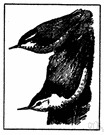Both the pygmy nuthatch (Sitta pygmaea) and
red-breasted nuthatch (Sitta canadensis) were the rarest species recorded during our surveys and were only found in the unburned forest (Fig.
It landed softly and, a few steps later, I was looking down at a male
red-breasted nuthatch -- the first and only one I've ever seen in downtown Chicago.
I also took a birdwatching walk with naturalist Rich MacDonald of Bar Harbor's National History Centre from Sieur de Monts Spring, in the shadow of the mountain named after George Dorr, and saw black-capped chickadees,
red-breasted nuthatch, and a beautiful gold-crowned kinglet.
The ones that shifted their range downslope include both low-elevation species like the Ash-throated Flycatcher and Western Scrub-Jay, and high-elevation species like the Cassin's Finch and
Red-breasted Nuthatch.
Here are a few winter birds and their favorite foods: Birds Foods Northern Cardinal safflower seeds, fruit, berries, nuts Black-Capped Chickadee hulled sunflower seeds, peanuts, berries Downy Woodpecker hulled sunflower seeds, tree nuts, fruit
Red-Breasted Nuthatch hulled sunflower seeds, peanuts Tufted Titmouse hulled sunflower seeds, fruits, nuts Dark-Eyed Junco white millet, cracked corn
An audacious
red-breasted nuthatch, just 4 1/2 inches long, lands on General Sherman's huge flank.
The
red-breasted nuthatch (left) is the most colorful one and the white-breasted nuthatch (below) is the biggest.
Three species (
Red-breasted Nuthatch, Varied Thrush, and Red Crossbill) demonstrated significant geographic variation in abundance at the patch level that could not be explained by annual variations (McGarigal 1993).
Nature Note: Inquisitive by nature, a
red-breasted nuthatch will approach fairly closely if you stand perfectly still.
Similarly, the chickadee and nuthatch winter observations were not of a roosting bird, but of a mixed species flock of 5 individuals who all entered a
Red-breasted Nuthatch cavity one at a time and then flew off.
Although the
red-breasted nuthatch and various finches consume some insect life during summer months, they feed largely on conifer cones or the catkins and seeds of deciduous trees, all of which are high off the ground.
Red-breasted Nuthatch (Sitta canadensis): Walks head first down trees; has a broad back line across and a white stripe above the eye.
 red-breasted nuthatch - bluish-grey nuthatch with reddish breast; of northern coniferous forests
red-breasted nuthatch - bluish-grey nuthatch with reddish breast; of northern coniferous forests